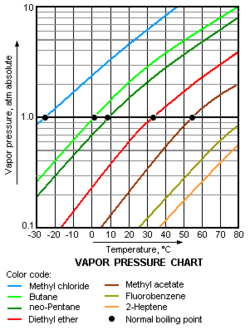CZ:Featured article/Current: Difference between revisions
imported>Chunbum Park mNo edit summary |
imported>Anthony.Sebastian (Milton did most of the work on this article and should get first billing) |
||
| Line 1: | Line 1: | ||
== '''[[Volatility (chemistry)]]''' == | == '''[[Volatility (chemistry)]]''' == | ||
''by [[User: | ''by [[User:Milton Beychok|Milton Beychok]] (and [[User:Anthony.Sebastian|Anthony.Sebastian]]) | ||
---- | ---- | ||
Revision as of 11:21, 9 January 2012
Volatility (chemistry)
by Milton Beychok (and Anthony.Sebastian)
In chemistry and physics, volatility is a term used to characterize the tendency of a substance to vaporize.[1] It is directly related to a substance' s vapor pressure. At a given temperature, a substance with a higher vapor pressure will vaporize more readily than a substance with a lower vapor pressure.[2][3][4] In other words, at a given temperature, the more volatile the substance the higher will be the pressure of the vapor in dynamic equilibrium with its vaporizing substance—i.e., when the rates at which molecules escape from and return into the vaporizing substance are equal.
In common usage, the term applies primarily to liquids. However, it may also be used to characterize the process of sublimation by which certain solid substances such as ammonium chloride (NH4Cl) and dry ice, which is solid carbon dioxide (CO2), change directly from their solid form to a vapor without becoming a liquid.
Any substance with a significant vapor pressure at temperatures of about 20 to 25 °C (68 to 77 °F) is very often referred to as being volatile.
Vapor pressure, temperature and boiling point
The vapor pressure of a substance is the pressure at which its gaseous (vapor) phase is in equilibrium with its liquid or solid phase. It is a measure of the tendency of molecules and atoms to escape from a liquid or solid.
At atmospheric pressures, when a liquid's vapor pressure increases with increasing temperatures to the point at which it equals the atmospheric pressure, the liquid has reached its boiling point, namely, the temperature at which the liquid changes its state from a liquid to a gas throughout its bulk. That temperature is very commonly referred to as the liquid's normal boiling point.
Not surprisingly, a liquid's normal boiling point will be at a lower temperature the greater is the tendency of its molecules to escape from the liquid, namely, the higher is its vapor pressure. In other words, the higher is the vapor pressure of a liquid, the higher is the volatility and the lower is the normal boiling point of the liquid. The adjacent vapor pressure chart graphs the dependency of vapor pressure upon temperature for a variety of liquids[5] and also confirms that liquids with higher vapor pressures have lower normal boiling points.
| notes |
|---|
|
